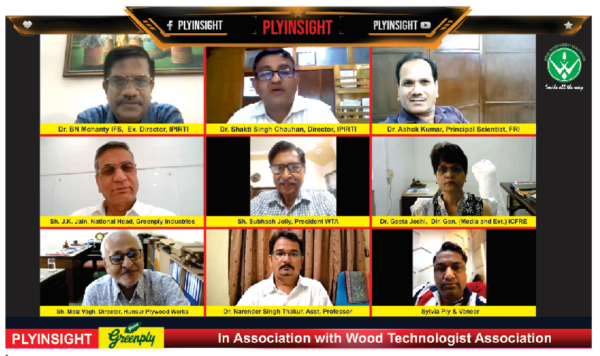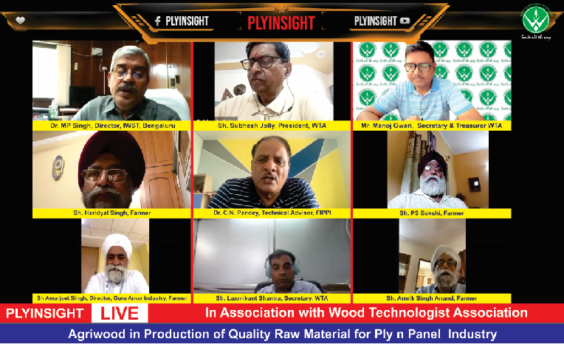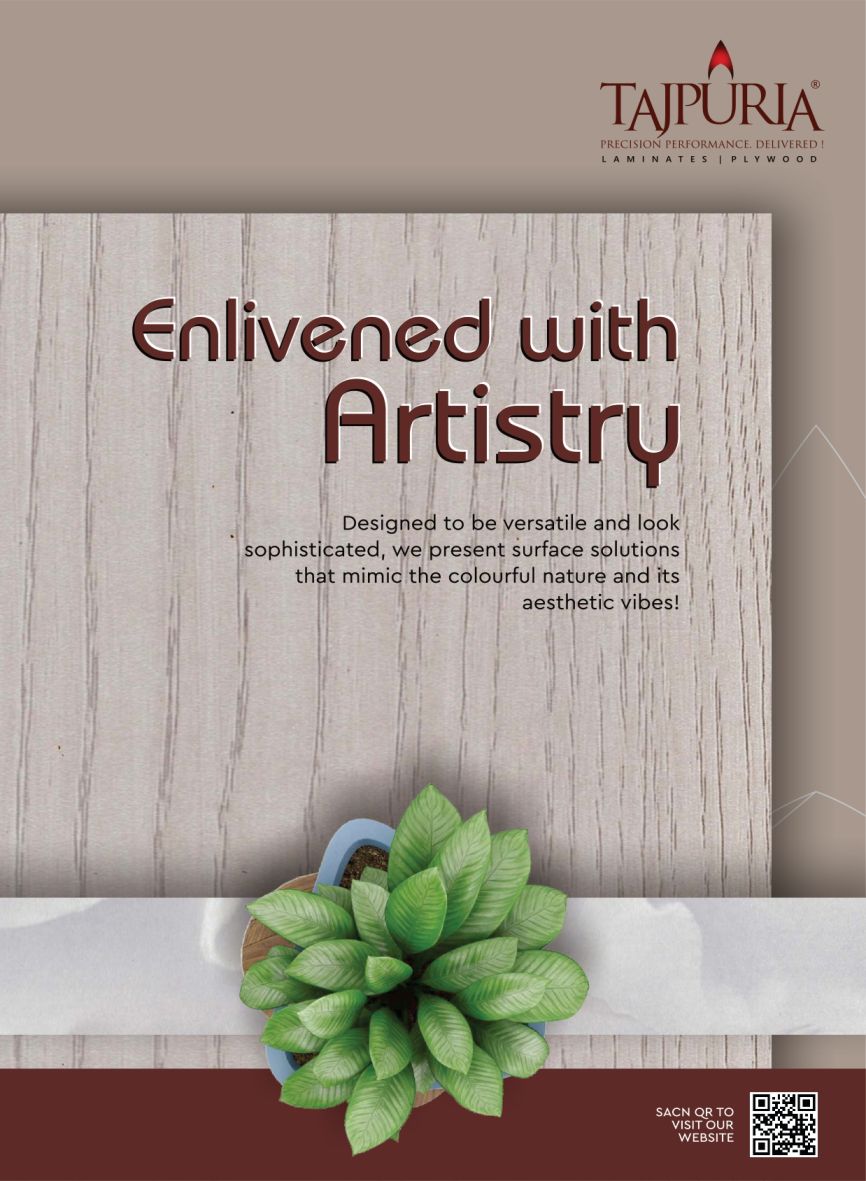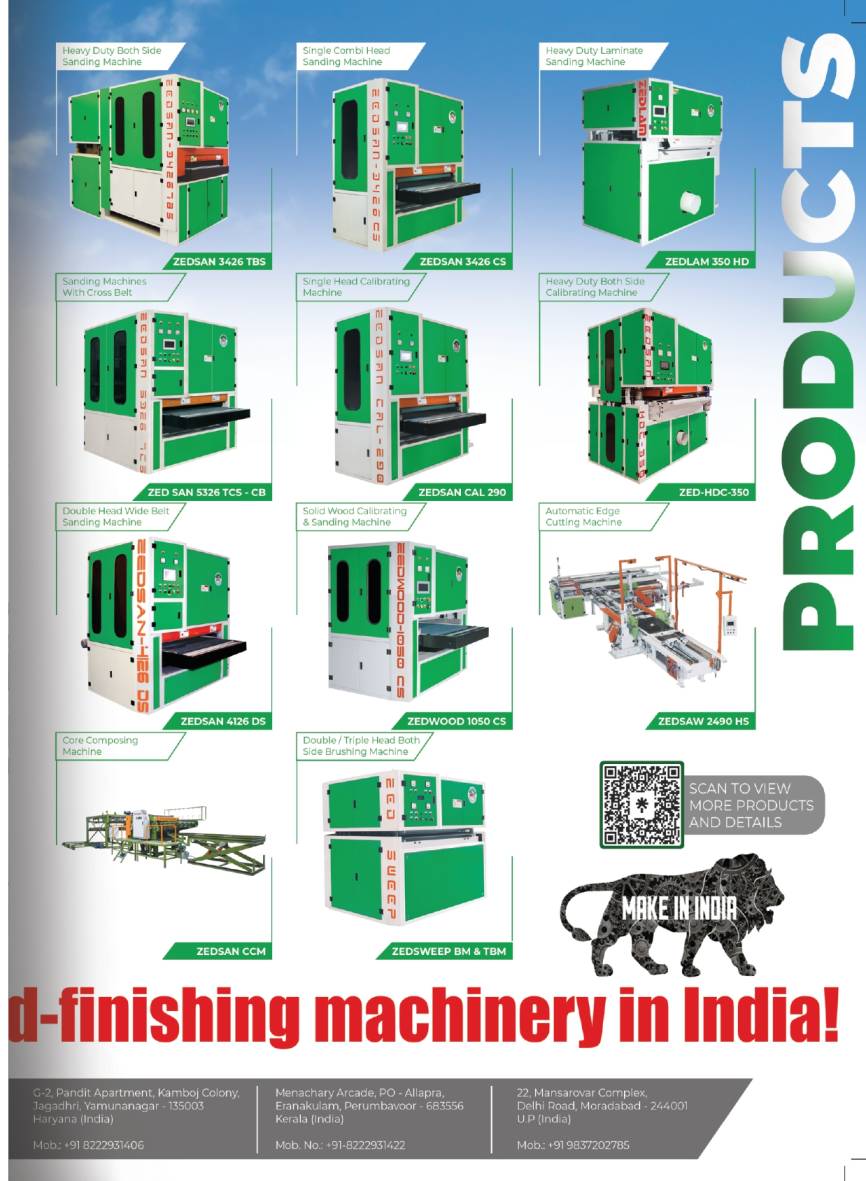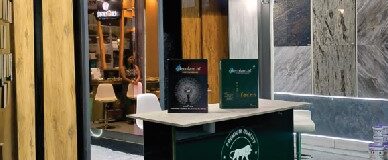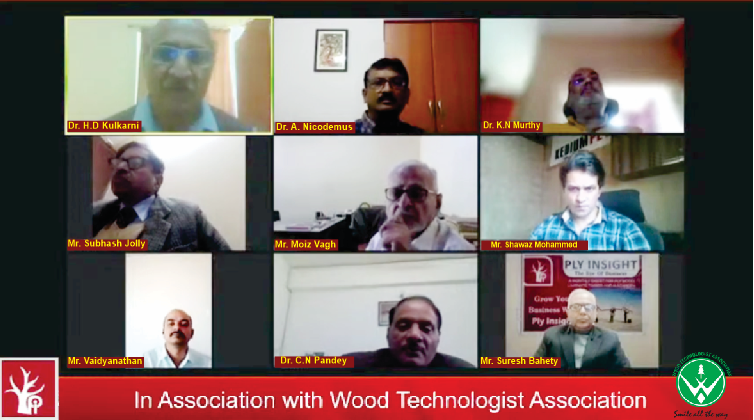
‘Strategies for enhanced role of Agroforestry in WBI of South India – Experiences & Way forward’
- March 10, 2022
- 0
‘दक्षिण भारत के WBI में कृषि वानिकी की बढ़ी हुई भूमिका के लिए रणनीतियाँ – अनुभव और आगे का रास्ता’
JANUARY 29, 2022
Honorable Panelists
- Dr. M P Singh- Director, Institute of Wood Science & Technology, Bengaluru
- Mr. Moiz Vagh- Director, Hunsur Plywood Works, Karnataka
- Dr. H. D. Kulkarni- Forestry & Sustainability Consultant, Ex V.P. Plantation, ITC.
- Dr. C. N. Pandey- Technical Advisor, FIPPI, Ex. Director, IPIRTI
- Mr. Subhash Jolly- President, Wood Technologist Association
- Mr. Siraj Asger Ali- Representing SIPMA, MD, Muffadel Timber & Allied Ind.
- Dr. A. Nicodemus- Scientist ‘G’, IFGTB, Coimbatore
- Dr. Ajay Thakur- Scientist, Forest Research Institute
- Dr. K. N. Murthy- Ex PCCF, Karnataka
- Mr. Shawaz Mohammed- Director, Expertise Group, Mangalore
- Mr. Dharmendra Kumar Daukia- VP, Raw Material, Green Panel Ind. Ltd.
- Mr. B. R. Narayanaswami- Farmer, CEO – Coimbatore Agroforestry & Farmer Producer Co. Ltd.
- Mr. Vaidyanathan Hariharan- WTA & Founder Director, Kalpaka RDF
- Mr. Manoj Thakur- Senior Editor, PLY insight
- Mr. Suresh Bahety- Founder Editor, PLY insight
Introductory remarks from Shri Subhash Jolly, President WTA.
- Mr Jolly remarked on the significant role played by FIPPI with regard to the subject & requested Dr C. N. Pandey to provide some good news which maybe a milestone for our industry.
Dr. M. P. Singh:
- We really want to see what are the learnings from South India which can be utilized in the North too. That is the objective of this webinar.
- How the role of Agroforestry (AF) can be enhanced with regard to WBI.
- We will try to understand all the aspects related to role of AF & WBI in augmenting raw materials (RM) & species also.
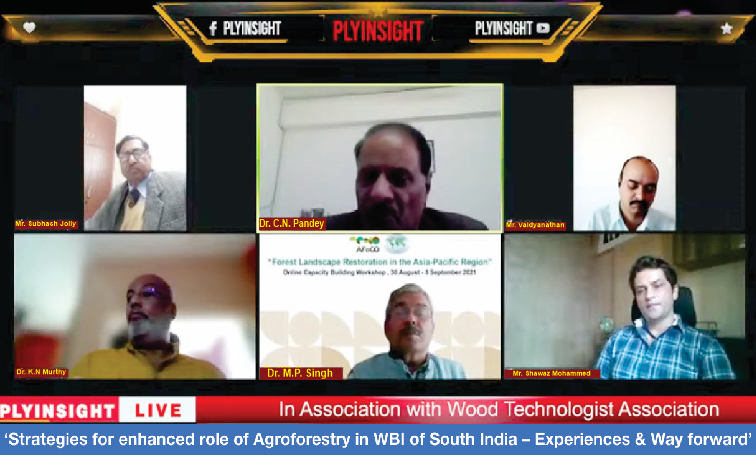
Dr. C. N. Pandey:
- FIPPI has taken up a lot of responsibilities and representations with regard to the plywood industry (PWI) and also related panel industries.
- We really need to understand where we have failed as an industry. What are we trying to address? What are our priorities? What is the purpose?
- Many times during the last two years and even earlier we have been talking about these problems. It is now time for us to act on these.
- What roadmap we should prepare?
- Raw material security is a primary issue in WBI.
- After a lot of discussions and pondering, we arrived at a conclusion that if only extra 5% of our agricultural land is utilised for AF, then we will have around 7.5 M Ha of AF plantations (out of 150 M Ha used in agriculture).
- This will ensure AF raw material supply for a period upto 2030.
- As per a report, PWI & panel industry demand in 2021 was 15.47 M CBM in India. Our PWI production is around 10 M CBM & around 12.5 M CBM including PB & MDF. So there is still a gap of 3 to 4 M CBM.
- As housing requirements, education & spending power increase steadily, the plywood & panel requirements in India is projected to reach 57.5 M CBM by 2030.
- Our industry faces major RM crunch in face veneers (FV). There is meagre contribution from local AF timber for FV currently.
Mr. Moiz Vagh:
- Thanks to our farmer friends, without whose contribution we would be nowhere today.
- We must realise that our entire PWI uses 100% farm resource in India.
- But there are some mismatches that need to be corrected on the farm front. How to grow quality seedlings? Mechanisms to avoid mistakes in timber choices and quality. If mistakes happen because of ignorance of the farmer, who will buy the timber? Again farmer has to bear the consequence, mainly.
- Since 2005, we are 100% running on plantation timber. Understanding the ideal species is most important.
- Rubber & Silver oak are dependent on good rainfall.
- Melia Dubia is a native species that grows anywhere. We have also heard of it’s large plantations in China & Africa.
- Most important fact is it can produce quality face veneer.
- We need to inform the farmer in the right way. Farmer is told some information about spacing etc. If quality of timber suffers, farmer will ultimately suffer. Need for right information provided to the farmer is important.
- We must focus on quality seedlings, Quality Plantation Material, and appropriate knowledge has to be given.
Mr. Narayanaswami :
- Since 2002 September, we have been meeting with farmers monthly, for 218 months.
- We have a subscriber base of 700 to 1000 farmers.
- We make sure to update farmers regularly, with the help of officers and scientists.
- We are in regular touch with scientists from IFGTB for improving AF in the region.
- Farmers spend 800 to 900 rupees per ton to cut the trees.
- We have agreements with some plywood producers and have arrived at a minimum price range of 6,000 to 8,500 rupees, per M.T.
- Melia Dubia has given the best value for farmers with regard to timber for WBI.
- However, there are lot of issues in reality till now.
- We do not have single window facilities & marketing support.
- There are different departments for different species. When everything is grown in agricultural land by a farmer, why have such complications?
- We are short of quality planting materials. There are a lot of subsidy problems too. Since there is lack of quality TC saplings, departments instruct farmers to buy from outside and submit bills.
- Farmers are very much interested in AF.
- But we need single point contact for sales of wood produce. Timber merchants have deep influence in profits. There must be direct sale points.
- Suggest government to form wood council for AF development & value addition in timber.
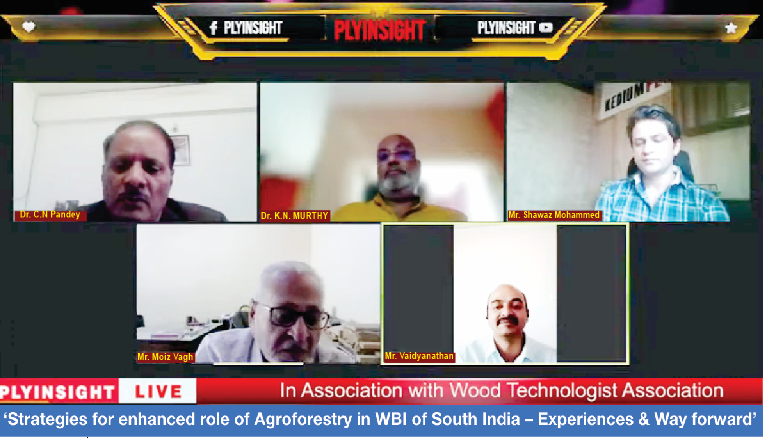
Dr. K. N. Murthy:
- There has been wood balance study done in Karnataka.
- As per the latest State of Forest report 2.8% of the geographical area in Karnataka is under AF.
- AF sector is growing very well and looking good to improve over the coming years.
- Karnataka has a growing stock of 121 M CBM, at 6 CBM per Ha annual productivity.
- With regard to WBI, there are only few big industries in Karnataka, in addition to around 5,000 small users of timber.
- There has also been lot of monopolising of species by certain industries, especially the case of paper industries who pay 2,500 rupees / ton at the gate, inclusive of transportation, middlemen etc.
- In such a case how do we expect the farmers to grow and gain interest in AF? We need to really see what the farmer is actually getting as his price for AF produce.
- Huge quantity of silver oak is available in Karnataka which can be taken advantage by WBI.
- Importers are giving good money for other imported species, but silver oak has not been getting the price it deserves.
- Any amount of Teak is available, and it is being sold at 15-18,000 per ton at the farm.
- But plantations are not managed well, which needs to be addressed.
- We are setting up a digital platform soon. My company is ready, we are here, and we can bridge the gaps.
- We have supplied 1500T of Melia Dubia in 3 months. Many from Maharashtra, Kerala & Andhra are purchasing timber from Karnataka.
Dr. H. D. Kulkarni:
- Industry has to take initiative to spread plantations with the quality of material they require.
- South India has definitely led with various wood plantation initiatives over the years.
- However, there were not much investments into AF happening from the industry side.
- Andhra had raised 3 lac Ha in AF. 45 lac Tons of wood is extracted.
- Ongole was leading the AF plantation initiatives with many big & influential people.
- Wood trade was happening but plantation management was not happening.
- Therefore, we have seen about 40% of plantations uprooted because of lack of price in Andhra. Somewhat imilar situation was seen in certain parts of Karnataka too and farmers started uprooting their plantations. This is a sad situation. The farmers are left high and dry in such situations.
- We need to have some benchmark prices for pulp – say 3,000 to 3,500 at the farm.
- I would like to submit to the Karnataka State Forests Dept about the ban on Eucalyptus. Banning is a bad practice. We must regulate, rather than ban. Ban should be based on region wise scientific studies. Else, the farmers will be left high and dry.
- Tamil Nadu have banned interstate transportation of Eucalyptus. Such banning practices need to be revisited and performed in a regulated manner instead.
- Farmers must be supported to first study and then plant species for AF.
- Industry-Farmer communication is a must, and they must have a wonderful tie-up.
- Middlemen are powerful people & groups. I have faced their wrath in certain occasions.
- Companies can think of introducing Logging Dept in order to manage wood resources, and to nsure that wood is harvested scientifically and linking directly with the farmers. Optimization will happen in this way.
- Regarding face veneers, some 22 species were identified for peeling face veneers.
- Preference should be given to development of indigenous species.
- IPIRTI may become the flag bearer for all these activities regarding PWI & Panel industries.
Dr. A. Nicodemus:
- More than 2/3rds of plantations come from improved varieties.
- Periodic WBI productivity should take into account future plantation resources requirement also.
- Any amount of research can be done, but ultimately its reach can happen only from the industry.
- Presence of PWI must be felt by the farmers. The paper & pulp industries models can be integrated for requirements of PWI.
- Industry can also jointly undertake researches based on quality requirements with regard to what & how they want their resources.
- For the past 30 years it is only quantity, not quality. Industries have to involve in farm quality for overall progress.
- We can tailor make species based on specific quality requirements like girth & colour too.
- Whatever we try to improve, production has to start from the farm, not after RM reaching the factories. Plantation planning and multiple species should also be looked at.
Mr. Shawaz Mohammed:
- Industry needs a single organization for plantation management.
- The organization should carry all the PWI together.
- This has to be taken up very seriously. I am ready to do any coordination in this regard.
- We have many experienced people in our industry sector which can be utilised to strengthen our sector.
Mr. Moiz Vagh:
- Melia Dubia price points range from 4-5000 per ton up to 7,500 per ton to the farmers. Up to 15000 price is given based on quality of timber. We provide best value to farmers. This has been our regular practice.
- Our model of working is open to all to come and study.
- But there have been lot of wrong promotions in wrong locations with wrong practices. Famers need to be supported to study the species they want to grow. They must be educated properly.
- Silver oak is also getting good price of around 400 per CFt, contrary to some experiences. But it is not as much viable for PWI as MD with regard to quality of plywood.
- Also, Melia Dubia generates the best face veneers.
Mr. Dharmendra Kumar Daukia:
- WBI must find resources themselves & work towards it. Captive plantations across China, Indonesia, Brazil, and such other countries can be studied appropriately.
- Paper industry model can be integrated for PWI.
- Raising catchment resources is vital, especially in the North. There has to be WBI involvement.
- Those industries who are not doing it, please do it NOW.
- Please visit big industries collectively & learn from them.
- Have confidence, and try to raise confidence. We are available for any input required.
- 4 years down the line, industries will remember these words, if they do not do it now.
Mr. Bimal Chopra:
- The North is now facing shortages and price fluctuations due to ignoring of plantation aspects.
- We have to learn and speed up on raising plantation resources.
- The government should do away with license charges and mandate plantation development depending on capacity of an industry.
Dr. C. N. Pandey:
- There is a big gap between industry & tree growers.
- If not attended today, industry will have more problems in the future.
- For everything we should not depend on the government. Let industry come forward.
- RM resources can be expanded to many other wood species also.
Mr.Siraj Asger Ali:
- We depend solely on farmers. Unless & until we pay fair price to farmers, it will be difficult to organize resources ahead.
- We need to convince farmers not to cut premature timber.
- Industries should decide not to use juvenile timber, which reduces quality of products drastically.
- Many other species grown in Karnataka. We must persuade and convince government to deregulate timber growing.
- We must find ways and means to encourage farmers to grow more timber.
Mr. Subhash Jolly:
- Requested Mr. Moiz Vagh’s views on significance of 8′ peeling.
- Requested North PWIs to involve more into development of indigenous species, especially with a focus on Melia Dubia for superior core veneer & face veneers.
Mr. Moiz Vagh:
- We need to put more 8′ peeling. And create good quality panel cores.
- This will improve whole of the PWI sector.
- 100% of our Face Veneer is from MD. Farmers have to be educated & hand-held by us, encouraging them to wait until they have good girth timber, resulting in higher profits too.
Concluding Remarks from Dr. M. P. Singh:
Dr. M. P. Singh:
- Currently industry in South does not have RM problems because (the guidelines have not been implemented &) there are fewer industries.
- A few industries have also moved to neighboring Andhra, because of lack of proper WBI guidelines.
- So we need to have State level, and even Regional level organizations in order to support farmers & augment our RM requirements, and wood resources in general.
- It is really surprising that a State like Karnataka has not provided focus to development of WBIs. It has not been able to implement the guidelines of Centre surprisingly. The State has been moving more on a conservative side.
- Karnataka farmers are very progressive & the State can take a lead by setting an example.
- If we follow the GoI guidelines, it is only registration as far as the PWI, PB & MDF are concerned.
- When we facilitate the industry, they will optimize their capacity also, & they will undertake expansion too.
- Should be a win-win situation for all. We have written to the Karnataka SFD. They have a backlog of 5 years and are expected to revert after framing their guidelines.
- I would request SIPMA to join forces also. SIPMA can also have a Council, supported by the industries. They need not wait for the government to setup councils.
- We need more industries to create the demand & support more farmers to get into AF.
- Karnataka State can lead by example, and we need to work together.
Dr. H. D. Kulkarni (Chat):
- Wood shortage phase in South India may happen around 2025-2026. Industry should be proactive in taking up more plantations to avoid difficult situations.
Mr. Dharmendra Kumar Duakia (Chat):
- Ply Insight may think of making a platform to bring together all stakeholders in the North.
- Congratulated Mr. Siraj Asger Ali, SIPMA & MR Moiz Vagh for providing support to farmers and bringing in their cause.
- Excellent suggestion by Mr. Bimal Chopra on plantation mandate for industries.
Mr. Subhash Jolly:
- It was a very fruitful Webinar. Profusely thank all the learned panelists for their input, support and knowledge-sharing for the benefit of industry & farmers.
- We have to keep up the pressure amongst us, in order to keep up focus and bring results.
- Just as all our parts & organs of the body are essential for optimum functioning, it is important that all of us stakeholders – industry, scientists of all our institutes, academicians, authorities & farmers work together in coordination, for our nation to progress. Jai Hind!
Comments from Vaidyanathan:
- A lot of fine points and discussions have been taken up in this fruitful & enriching webinar.
- It is now time for the PWI to come out of its inertia and start working together directly with farmers, in order for both the stakeholders to progress uniformly, hand-in-hand.
- Each of the regional PWI Associations, Panel Industry (PB, MDF, Bagasse Boards, Chip Boards etc) Associations can take their own regional initiatives to interact directly with farmers.
- These Associations may create their own Digital Platforms, which are not very costly to implement – in order to coordinate with Institutes & Certified nurseries for providing Quality Planting Materials (QPM), track plantation management aspects & involve directly in producing quality wood resources for the PWI & Panel sectors of the country.
- With all the superior levels & abilities of smartness, speed, brain-work, labour resources, and well supporting administrative scenario currently being experienced in our great nation, Bharat can soon become a leading example of AF resource building and ToF production for the world. Jai Hind!
श्री सुभाष जॉली, अध्यक्ष WTA से परिचयात्मक टिप्पणी।
- श्री जॉली ने इस विषय के संबंध में FIPPI द्वारा निभाई गई महत्वपूर्ण भूमिका पर टिप्पणी की और डॉ सीएन पांडे से अनुरोध किया कि वे कुछ अच्छी खबरें प्रदान करें जो शायद हमारे उद्योग के लिए एक मील का पत्थर हो।
डॉ एम पी सिंहः
- हम वास्तव में देखना चाहते हैं कि दक्षिण भारत से क्या सीख मिलती है जिसका उपयोग उत्तर में भी किया जा सकता है। यही इस वेबिनार का उद्देश्य है।
- WBI के संबंध में कृषि वानिकी (AF) की भूमिका को कैसे बढ़ाया जा सकता है।
- हम कच्चे माल (RM) और प्रजातियों को भी बढ़ाने में कृषि वाणिकी और WBI की भूमिका से संबंधित सभी पहलुओं को समझने की कोशिश करेंगे।
डॉ सी एन पांडेः
- FIPPI ने प्लाइवुड उद्योग (PWI) और संबंधित पैनल उद्योगों के संबंध में बहुत सारी जिम्मेदारियां और अभ्यावेदन उठाए हैं।
- हमें वास्तव में यह समझने की जरूरत है कि एक उद्योग के रूप में हम कहां असफल हुए हैं। हम क्या संबोधित करने की कोशिश कर रहे हैं? हमारी प्राथमिकताएं क्या हैं? उद्देश्य क्या है?
- पिछले दो वर्षों के दौरान कई बार और पहले भी हम इन समस्याओं के बारे में बात करते रहे हैं। अब समय आ गया है कि हम इन पर कार्रवाई करें।
- हमें कौन सा रोडमैप तैयार करना चाहिए?
- WBI में कच्चे माल की सुरक्षा एक प्राथमिक मुद्दा है।
- बहुत विचार-विमर्श और वार्तालाप के बाद, हम इस निष्कर्ष पर पहुंचे कि यदि हमारी अतिरिक्त सिर्फ 5 प्रतिशत कृषि भूमि AF में उपयोग कर ली जाती है, तो हमारे पास लगभग 7.5 लाख हेक्टेयर AF वृक्षारोपण होगा (कृषि में उपयोग किए जाने वाले 1500 लाख हेक्टेयर में से) )
- यह 2030 तक की अवधि के लिए AF से कच्चे माल की आपूर्ति सुनिश्चित करेगा।
- एक रिपोर्ट के अनुसार, 2021 में PWI और पैनल उद्योग की मांग भारत में 154.7 लाख CBM थी। हमारा PWI उत्पादन लगभग 10 लाख CBM और PB और MDF सहित लगभग 125 लाख CBM है। तो अभी भी 30 से 40 लाख CBM का अंतर है।
- जैसे-जैसे आवास की आवश्यकताएं, शिक्षा और खर्च करने की शक्ति में लगातार वृद्धि रही है, भारत में प्लाईवुड और पैनल की आवश्यकताएं 2030 तक 575 लाख CBM तक पहुंचने का अनुमान है।
- हमारा उद्योग फेस विनियर (FV) में प्रमुख RM संकट का सामना कर रहा है। वर्तमान में FV के लिए स्थानीय AF टिम्बर का बहुत कम योगदान है।
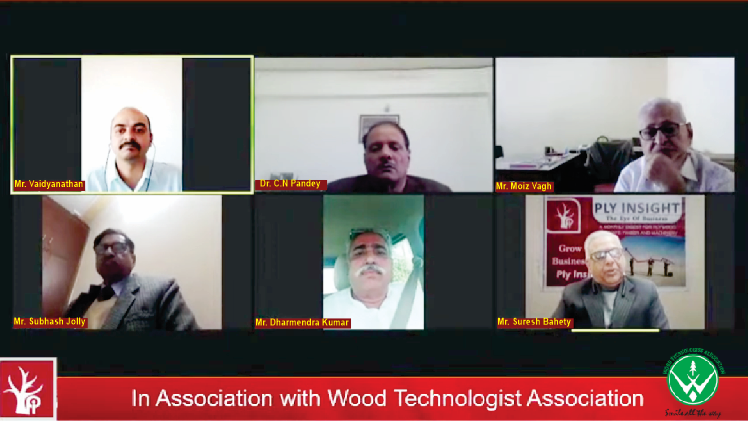
श्री मोइज़ वाघ:
- हमारे किसान मित्रों को धन्यवाद, जिनके योगदान के बिना हम आज कहीं नहीं होते।
- हमें यह महसूस करना चाहिए कि हमारा संपूर्ण PWI भारत में 100 प्रतिशत कृषि संसाधन का उपयोग करता है।
- लेकिन कुछ विसंगतियां हैं जिन्हें कृषि के मोर्चे पर ठीक करने की आवश्यकता है। गुणवत्तायुक्त पौध कैसे उगाएं? लकड़ी की पसंद और गुणवत्ता में गलतियों से बचने के लिए तंत्र। अगर किसान की अज्ञानता के कारण गलतियाँ होती हैं, तो लकड़ी कौन खरीदेगा? फिर से किसान को मुख्य रूप से इसका परिणाम भुगतना पड़ता है।
- 2005 से ही, हम वृक्षारोपण लकड़ी पर 100 प्रतिशत चल रहे हैं। आदर्श प्रजाति को समझना सबसे महत्वपूर्ण और जरूरी है।
- रबड़ और सिल्वर ओक अच्छी वर्षा पर निर्भर हैं।
- मेलिया दूबिया एक देशी प्रजाति है जो कहीं भी उग सकती है। चीन और अफ्रीका में भी इसके बड़े वृक्षारोपण के बारे में भी सुना गया है।
- सबसे महत्वपूर्ण तथ्य यह है कि मेलिया डुबिया गुणवत्ता वाले फेस विनियर का उत्पादन कर सकता है।
- हमें किसान को सही तरीके से सूचित करने की जरूरत है। किसान को ैचंबपदह आदि के बारे में कुछ जानकारी दी जाती है। यदि लकड़ी की गुणवत्ता खराब होती है, तो किसान को अंततः नुकसान होगा। किसान को सही जानकारी देना जरूरी है।
- हमें गुणवत्तापूर्ण पौध, QPM पर ध्यान देना चाहिए और उचित ज्ञान देना चाहिए।
श्री नारायणस्वामी:
- 2002 सितंबर से हम 218 महीनों से किसानों के साथ मासिक बैठक कर रहे हैं।
- हमारे पास 700 से 1000 किसानों की सदस्यता का आधार है।
- हम अधिकारियों और वैज्ञानिकों की मदद से किसानों को नियमित रूप से अपडेट करना सुनिश्चित करते हैं।
- हम क्षेत्र में AF में सुधार के लिए IFGTB के वैज्ञानिकों के साथ नियमित संपर्क में हैं।
- पेड़ काटने के लिए किसान 800 से 900 रुपये प्रति टन खर्च करते हैं।
- हमने कुछ प्लाईवुड उत्पादकों के साथ अनुबंध किया है और 6,000 से 8,500 रुपये प्रति M.T. की न्यूनतम कीमत निर्धारित की हुई हैं।
- मेलिया दुबिया नेWBI के लिए लकड़ी के संबंध में किसानों को सर्वाेत्तम मूल्य दिया है।
- हालांकि, अब भी वास्तविकता में बहुत सारे मुद्दे हैं।
- हमारे पास सिंगल विंडो सुविधाएं और मार्केटिंग सपोर्ट नहीं है।
- विभिन्न प्रजातियों के लिए अलग-अलग विभाग हैं। जब किसान द्वारा कृषि भूमि में सब कुछ उगाया जाता है, तो ऐसी जटिलताएँ क्यों हैं?
- हमारे पास गुणवत्तापूर्ण रोपण सामग्री की कमी है। सब्सिडी की भी काफी समस्या है। गुणवत्तापूर्ण टीसी पौधे नहीं होने के कारण विभाग किसानों को बाहर से खरीदने और बिल जमा करने का निर्देश देते हैं।
- किसानों की AF में रुचि बढ़ रही हैै।
- लेकिन हमें लकड़ी के उत्पाद की बिक्री के लिए सिंगल पॉइंट कॉन्टैक्ट की जरूरत है। मुनाफे में, इमारती लकड़ी के व्यापारियों का बड़ा हिस्सा है। सीधी और प्रत्यक्ष बिक्री होनी चाहिए।
- AF विकास और लकड़ी में मूल्यवर्धन के लिए सरकार को लकड़ी परिषद बनाने का सुझाव दिया जाना चाहिए।
डॉ के एन मूर्ति:
- कर्नाटक में लकड़ी के संतुलन का अध्ययन किया गया है।
- नवीनतम वन राज्य रिपोर्ट के अनुसार कर्नाटक में भौगोलिक क्षेत्र का 2.8 प्रतिशत हिस्सा AF के अधीन है।
- AF क्षेत्र बहुत अच्छी तरह से बढ़ रहा है और आने वाले वर्षों में इसमें सुधार की उम्मीद है।
- कर्नाटक में 6 CBM प्रति हेक्टेयर वार्षिक उत्पादकता के साथ 1210 लाख CBMका बढ़ता क्षेत्रफल है।
- कर्नाटक में लकड़ी के लगभग 5,000 छोटे उपयोगकर्ताओं के अलावा कुछ ही CBMके बड़े उद्योग हैं।
- कुछ उद्योगों द्वारा प्रजातियों का बहुत अधिक एकाधिकार भी किया गया है, विशेष रूप से कागज उद्योग।
- जो गेट पर 2,500 रुपये / टन का भुगतान करते हैं, जिसमें परिवहन, बिचैलिए आदि शामिल हैं।
- ऐसी स्थिति में हम किसानों के बढ़ने और AF में रुचि हासिल करने की उम्मीद कैसे कर सकते हैं? हमें वास्तव में यह देखने की जरूरत है कि किसान को AF उपज के लिए उसकी कीमत के रूप में वास्तव में क्या मिल रहा है।
- कर्नाटक में भारी मात्रा में सिल्वर ओक उपलब्ध है जिसका लाभ WBI उठा सकता है।
- आयातक अन्य आयातित प्रजातियों के लिए अच्छा पैसा दे रहे हैं, लेकिन सिल्वर ओक को वह मूल्य नहीं मिल रहा है जिसका वह हकदार हैं।
- टीक/सागौन कितनी भी मात्रा में उपलब्ध है, और यह खेत में 15-18,000 प्रति टन के हिसाब से बेचा जा रहा है।
- लेकिन वृक्षारोपण का प्रबंधन ठीक से नहीं किया जाता है, जिसका समाधान करने की आवश्यकता है।
- हम जल्द ही एक डिजिटल प्लेटफॉर्म स्थापित कर रहे हैं। मेरी कंपनी तैयार है, और हम अंतराल को पाट सकते हैं।
- हमने 3 महीने में 1500T मेलिया दूबिया की आपूर्ति की है। महाराष्ट्र, केरल और आंध्र के कई लोग कर्नाटक से लकड़ी खरीद रहे हैं।
डॉ एच डी कुलकर्णीः
- उद्योग को आवश्यक गुणवत्ता की सामग्री के लिए वृक्षारोपण बढ़ाने के लिए पहल करनी होगी।
- दक्षिण भारत ने निश्चित रूप से पिछले कुछ वर्षों में विभिन्न लकड़ी वृक्षारोपण की पहल की है।
- हालांकि, उद्योग की ओर से AF में अधिक निवेश नहीं हो रहा था।
- आंध्र ने AF में 3 लाख हेक्टेयर जुटाया था। 45 लाख टन लकड़ी निकाली जाती है।
- कई बड़े और प्रभावशाली लोगों के साथ ओंगोल AF वृक्षारोपण पहल का नेतृत्व कर रहा था।
- लकड़ी का व्यापार हो रहा था लेकिन वृक्षारोपण प्रबंधन नहीं हो रहा था।
- इसलिए, हमने देखा है कि आंध्र में कीमत की कमी के कारण लगभग 40 प्रतिशत वृक्षारोपण उखड़ गए हैं। कुछ इसी तरह की स्थिति कर्नाटक के कुछ हिस्सों में भी देखी गई और किसानों ने अपने बागानों को उखाड़ना शुरू कर दिया। यह दुखद स्थिति है। ऐसी स्थितियों में किसान भूखे और सूखे रह जाते हैं।
- हमें लुगदी के लिए कुछ बेंचमार्क मूल्य रखने की आवश्यकता है – जैसे कि खेत में 3,000 से 3,500।
- मैं यूकेलिप्टस पर प्रतिबंध के बारे में कर्नाटक राज्य वन विभाग को कहना चाहूंगा। प्रतिबंध लगाना एक बुरी प्रथा है। हमें प्रतिबंध के बजाय नियमन करना चाहिए। प्रतिबंध क्षेत्रवार वैज्ञानिक अध्ययन पर आधारित होना चाहिए। नहीं तो किसान उजड़ और सूखे रह जाएंगे।
- तमिलनाडु ने यूकेलिप्टस के अंतरराज्यीय परिवहन पर प्रतिबंध लगा दिया है। इस तरह के प्रतिबंध लगाने की प्रथाओं पर फिर से गौर करने और इसके बजाय एक विनियमित तरीका अपनाने की आवश्यकता है।
- AF के लिए किसानों को पहले अध्ययन और फिर पौधों की प्रजातियों के चयन के लिए सहयोग देना होगा।
- उद्योग-किसान वार्तालाप जरूरी है, और उनमें एक सुंदर गठजोड़ होना चाहिए।
- बिचैलिए शक्तिशाली लोग और समूह होते हैं। मैंने कुछ अवसरों पर उनके क्रोध का सामना किया है।
- कंपनियां लकड़ी के संसाधनों के प्रबंधन के लिए सीधे किसानों के साथ जोडकर लॉगिंग विभाग शुरू करने के बारे में सोच सकती हैं, सुनिश्चित करने के लिए कि लकड़ी को वैज्ञानिक रूप से काटा जाए। इस तरह से अधिकतम उपयोग होगा।
- फेस विनियर के संबंध में, फेस विनियर छीलने के लिए लगभग 22 प्रजातियों की पहचान की गई थी।
- देशी प्रजातियों के विकास को प्राथमिकता दी जानी चाहिए।
- IPIRTI-PWI और पैनल उद्योगों की इन सभी गतिविधियों के लिए ध्वजवाहक बन सकता है।
डॉ. ए. निकोडेमस:
- दो तिहाई से अधिक वृक्षारोपण उन्नत किस्मों से होता है।
- आवधिकWBI उत्पादकता को भविष्य की वृक्षारोपण संसाधनों की आवश्यकता को भी ध्यान में रखना चाहिए।
- कितनी भी मात्रा में शोध किया जा सकता है, लेकिन अंततः उद्योग से इसकी पहुंच हो सकती है।
- PWI की उपस्थिति को किसानों द्वारा महसूस किया जाना चाहिए। PWI की आवश्यकताओं के लिए कागज और लुगदी उद्योग मॉडल को एकीकृत किया जा सकता है।
- उद्योग अपने संसाधनों में गुणवत्ता आवश्यकताओं को क्या और कैसा चाहते हैं, इस में गुणवत्ता आवश्यकताओं के आधार पर संयुक्त रूप से शोध भी कर सकते हैं।
- पिछले 30 वर्षों से यह केवल मात्रा है, गुणवत्ता नहीं। उद्योगों को समग्र प्रगति के लिए कृषि गुणवत्ता को बढ़ाना होगा।
- हम विशिष्ट गुणवत्ता परिधि और रंग जैसी आवश्यकताओं के आधार पर भी प्रजातियाँ बना सकते हैं।
- हम जो भी सुधार करने की कोशिश करते हैं, उत्पादन खेत से शुरू होना चाहिए, न कि कच्चे माल के कारखानों में पहुंचने के बाद। वृक्षारोपण योजना और कई प्रजातियों को भी देखा जाना चाहिए।
श्री शवाज मोहम्मद:
- उद्योग को वृक्षारोपण प्रबंधन के लिए एक ही विशिष्ठ संगठन की आवश्यकता है।
- संगठन को सभी PWI को साथ लेकर चलना चाहिए।
- इसे बहुत गंभीरता से लिया जाना चाहिए। मैं इस संबंध में कोई भी समन्वय करने को तैयार हूं।
- हमारे उद्योग क्षेत्र में हमारे पास कई अनुभवी लोग हैं जिनका उपयोग हमारे क्षेत्र को मजबूत करने के लिए किया जा सकता है
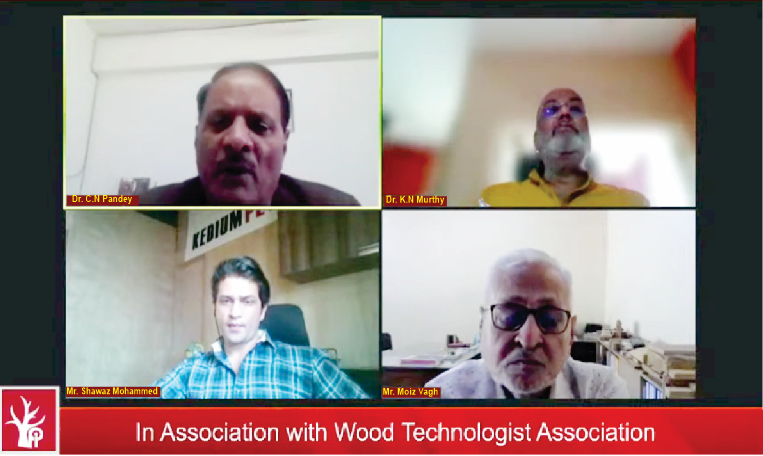
श्री मोइज़ वाघ:
- मेलिया दूबिया की कीमत किसानों को 4-5000 प्रति टन से लेकर 7,500 प्रति टन तक होती है। 15000 तक कीमत लकड़ी की गुणवत्ता के आधार पर दी जाती है। हम किसानों को सर्वाेत्तम मूल्य प्रदान करते हैं। यह हमारा नियमित अभ्यास रहा है।
- हमारे काम करने का मॉडल सभी के अध्ययन करने के लिए लिए खुला है।
- लेकिन गलत नितियों के साथ गलत स्थानों पर बहुत सारे गलत प्रचार हुए हैं। जिस प्रजाति को वे विकसित करना चाहते हैं, उसका अध्ययन करने के लिए किसानों को समर्थन देने की आवश्यकता है। उन्हें ठीक से शिक्षित किया जाना चाहिए।
- कुछ अनुभवों के विपरीत सिल्वर ओक को भी लगभग Rs. 400 प्रति सीएफटी की अच्छी कीमत मिल रही है। लेकिन यह प्लाईवुड की गुणवत्ता के संबंध में PWI के लिए MD जितना व्यवहार्य नहीं है।
- साथ ही, मेलिया दूबिया बेहतरीन फेस विनियर बनाती है।
श्री धर्मेंद्र कुमार डौकिया:
- WBI को स्वयं संसाधन तलाशने चाहिए और इस दिशा में काम करना चाहिए। चीन, इंडोनेशिया, ब्राजील और ऐसे अन्य देशों में कैप्टिव वृक्षारोपण का उचित अध्ययन किया जा सकता है।
- PWI के लिए कागज उद्योग मॉडल को एकीकृत किया जा सकता है।
- विशेष रूप से उत्तर में जलग्रहण संसाधन बढ़ाना महत्वपूर्ण है। PWI की भागीदारी होनी चाहिए।
- जो उद्योग ऐसा नहीं कर रहे हैं, कृपया अभी करें।
- कृपया बड़े उद्योगों का सामुहिक दौरा करें और उनसे सीखें।
- भरोसा रखें, और आत्मविश्वास बढ़ाने की कोशिश करें। हम किसी भी आवश्यक इनपुट के लिए उपलब्ध हैं।
- 4 साल बाद, उद्योग इन शब्दों को याद रखेंगे, अगर वे अभी नहीं करते हैं।
श्री बिमल चोपड़ाः
- वृक्षारोपण पहलुओं की अनदेखी के कारण उत्तर भारत अब कच्चे माल की कमी और कीमतों में उतार-चढ़ाव का सामना कर रहा है।
- हमें सीखना होगा और वृक्षारोपण संसाधन कर जुटाने में तेजी लानी होगी।
- सरकार को लाइसेंस शुल्क को हटा कर उद्योग की क्षमता के आधार पर वृक्षारोपण विकास को अनिवार्य कर देना चाहिए।

डॉ सी एन पांडेः
- उद्योग और पेड़ उगाने वालों किसानों के बीच एक बड़ा अंतर है।
- अगर आज ध्यान नहीं दिया गया तो भविष्य में उद्योगों को और अधिक समस्याएँ होंगी।
- हर चीज के लिए हमें सरकार पर निर्भर नहीं रहना चाहिए। उद्योग जगत को आगे आने दें।
- RM संसाधनों का विस्तार लकड़ी की कई अन्य प्रजातियों में भी किया जा सकता है।
श्री सिराज असगर अली:
- हम पूरी तरह से किसानों पर निर्भर हैं। जब तक हम किसानों को उचित मूल्य नहीं देंगे, आगे संसाधनों को व्यवस्थित करना मुश्किल होगा।
- हमें किसानों को घबराहट में समय से पहले लकड़ी न काटने के लिए आश्वासन देने की जरूरत है।
- उद्योगों को कम उम्र की लकड़ी का उपयोग नहीं करने का निर्णय लेना चाहिए, जिससे उत्पादों की गुणवत्ता में भारी गिरावट से बचा जा सके।
- कर्नाटक में उगाई जाने वाली कई अन्य प्रजातियां हैं। हमें सरकार को लकड़ी उगाने को विनियमित करने के लिए राजी करना और समझाना चाहिए।
- हमें किसानों को अधिक लकड़ी उगाने के लिए प्रोत्साहित करने के तरीके और साधन खोजने होंगे।
श्री सुभाष जॉलीः
- 8’’ पीलींग के महत्व पर श्री मोइज़ वाघ के विचारों का अनुरोध किया गया।
- उत्तरी PWI से स्वदेशी प्रजातियों के विकास में अधिक शामिल होने का अनुरोध किया, विशेष रूप से बेहतर कोर विनियर और फेस विनियर के लिए मेलिया दूबिया पर ध्यान देने के लिए।
श्री मोइज़ वाघः
- हमें और अधिक 8’ पीलींग लगानी होगी। और अच्छी क्वालिटी के पैनल कोर बनाना होगा।
- इससे संपूर्ण PWI क्षेत्र में सुधार होगा।
- हमारे फैक्ट्री में फेस वीनियर का 100 प्रतिशत M Dubia से है। हमें किसानों को शिक्षित और सहारा देना होगा। उन्हें तब तक इंतजार करने के लिए प्रोत्साहित करना होगा जब तक कि उनके पास अच्छी मोटाई की लकड़ी न हो, जिसके परिणामस्वरूप उच्च लाभ भी हो।
डॉ एम पी सिंह की ओर से समापन टिप्पणीः
डॉ एम पी सिंहः
- वर्तमान में दक्षिण में उद्योग में RM समस्या नहीं है (क्योंकि दिशानिर्देशों को लागू नहीं किया गया है और) कम उद्योग हैं।
- WBI के उचित दिशा-निर्देशों की कमी के कारण कुछ उद्योग पड़ोसी राज्य आंध्र में भी चले गए हैं।
- इसलिए किसानों को समर्थन देने और हमारी RM आवश्यकताओं, और सामान्य रूप से लकड़ी के संसाधनों को बढ़ाने के लिए हमें राज्य स्तर और यहां तक कि क्षेत्रीय स्तर के संगठनों की आवश्यकता है।
- यह वास्तव में आश्चर्यजनक है कि कर्नाटक जैसे राज्य नेWBI के विकास पर ध्यान नहीं दिया है। केंद्र के दिशा-निर्देशों को आश्चर्यजनक रूप से लागू नहीं कर पाई है। राज्य रूढ़िवादी पक्ष पर अधिक आगे बढ़ रहा है।
- कर्नाटक के किसान बहुत प्रगतिशील हैं और राज्य एक मिसाल कायम करके आगे बढ़ सकता है।
- यदि हम भारत सरकार के दिशानिर्देशों को समझते हैं, तो यह केवल पंजीकरण है जहां तक PWI, PB और MDF का संबंध है।
- जब हम उद्योग को सुविधा प्रदान करेंगे, तो वे अपनी क्षमता का भी अनुकूलन करेंगे, और वे विस्तार भी करेंगे।
- सभी के लिए लाभप्रद स्थिति होनी चाहिए। हमने कर्नाटकSFD को लिखा है। उनके पास 5 साल का बैकलॉग है और उनके दिशानिर्देश तैयार करने के बाद वापस लौटने की उम्मीद है।
- मैं सिप्मा से भी AF में शामिल होने का अनुरोध करूंगा SIPMA में उद्योगों द्वारा समर्थित एक परिषद भी हो सकती है। उन्हें परिषदों की स्थापना के लिए सरकार की प्रतीक्षा करने की आवश्यकता नहीं है।
- हमें मांग सृजित करने और AF में आने के लिए अधिक किसानों का समर्थन करने के लिए और अधिक उद्योगों की आवश्यकता है।
- कर्नाटक राज्य उदाहरण के तौर पर नेतृत्व कर सकता है, और हमें मिलकर काम करने की जरूरत है।
डॉ एच डी कुलकर्णी (चैट):
- दक्षिण भारत में लकड़ी की कमी का चरण 2025-2026 के आसपास हो सकता है। उद्योग को कठिन परिस्थितियों से बचने के लिए अधिक वृक्षारोपण करने में सक्रिय होना चाहिए।
श्री धर्मेंद्र कुमार दोकिया (चैट) :
- प्लाई इनसाइट उत्तर में सभी हितधारकों को एक साथ लाने के लिए एक मंच बनाने के बारे में सोच सकता है।
- श्री सिराज असगर अली, सिप्मा और एमआर मोइज़ वाघ को किसानों को सहायता प्रदान करने और उनकी कठिनाइयों को सामने लाने के लिए बधाई दी।
- उद्योग के लिए वृक्षारोपण जनादेश पर श्री बिमल चोपड़ा द्वारा उत्कृष्ट सुझाव दिया गया।
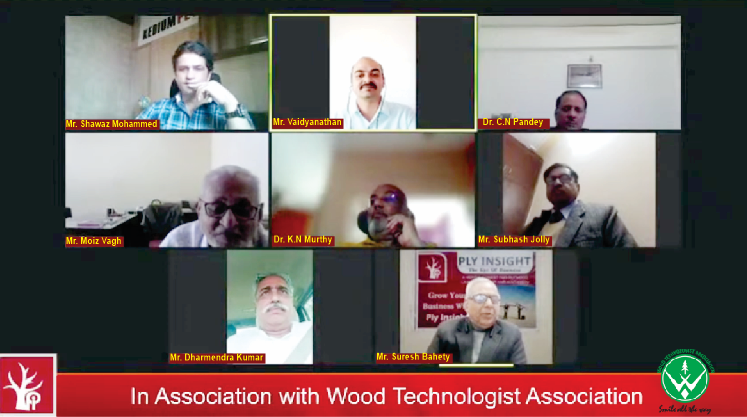
श्री सुभाष जॉलीः
- यह एक बहुत ही उपयोगी वेबिनार था। उद्योग और किसानों के लाभ के लिए सभी विद्वान पैनलिस्टों को उनके इनपुट, समर्थन और ज्ञान-साझा करने के लिए तहे दिल से धन्यवाद।
- फोकस बनाए रखने और परिणाम लाने के लिए हमें अपने बीच दबाव बनाए रखना होगा।
- जिस प्रकार हमारे शरीर के सभी अंग और हिस्से इष्टतम कामकाज के लिए आवश्यक हैं, यह महत्वपूर्ण है कि हम सभी हितधारक – उद्योग, हमारे सभी संस्थानों के वैज्ञानिक, शिक्षाविद, अधिकारी और किसान एक साथ मिलकर काम करें, ताकि हमारे देश की प्रगति हो सके। जय हिन्द!
वैद्यनाथन की टिप्पणियाँः
- इस उपयोगी और समृद्ध वेबिनार में बहुत सारे अच्छे बिंदु और विचार-विमर्श किए गए हैं।
- अब समय आ गया है कि PWI अपनी जड़ता से बाहर आए और किसानों के साथ सीधे मिलकर काम करना शुरू करे, ताकि दोनों हितधारक एक समान रूप से प्रगति कर सकें।
- प्रत्येक क्षेत्रीय PWI संघ, पैनल उद्योग ( PB, MDF बगास बोर्ड, चिप बोर्ड आदि) संघ किसानों के साथ सीधे बातचीत करने के लिए अपनी क्षेत्रीय पहल कर सकते हैं।
- ये संघ अपने स्वयं के डिजिटल प्लेटफॉर्म बना सकते हैं, जिन्हें लागू करना बहुत महंगा नहीं है – गुणवत्तापूर्ण रोपण सामग्री (QPM) प्रदान करने के लिए संस्थानों और प्रमाणित नर्सरी के साथ समन्वय करने के लिए, वृक्षारोपण प्रबंधन पहलुओं को ट्रैक करने और गुणवत्ता वाले लकड़ी के संसाधनों के उत्पादन में सीधे शामिल होने के लिए। देश के PWI और पैनल सेक्टर।
- उद्योगपतियों की बु़िद्वमता के उच्चतम स्तर और क्षमताओं के साथ, तेज कार्यशैली, सुगम कार्यबल और सहयोगी प्रशासनिक परिदृश्य, जो अभी हमारे महान देश में परिलक्षित हो हो रहा है। भारत जल्द ही दुनिया के लिए AF संसाधन निर्माण और ToF उत्पादन का एक प्रमुख उदाहरण बन सकता है। जय हिन्द!

